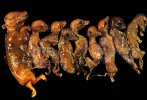Porcine parvovirus infection
Parvovirus affects mainly non-vaccinated primiparous sows, causing reproductive problems such as mummies.
Alternative names: PPV
Information
It is the most frequent and important cause of infectious infertility in gilts. Porcine parvovirus is a very resistant virus that normally multiplies in the pig’s intestine without causing any clinical sign. It is found worldwide, thus, it is an infection we must learn to live with and handle. Parvovirus can persist outside the pig for several months and is resistant to most disinfectants. Maybe this explains why the virus is so extended and hard to eliminate.
Symptoms
Sows (mainly gilts)
- Small litters associated to embryo losses before 35 days of pregnancy.
- Mummified piglets of various sizes.
- Increase in the number of stillborns.
- Abortions associated to parvovirus are not frequent.
- The acute disease can last up to 8 weeks and after that decline for 4 to 6 weeks, followed by shorter periods of time with the presence of mummies during other 4 to 6 weeks.
- The virus can take up to 4 months in infecting all the sows and gilts of a naive population.
- No other symptoms are present in breeding sows or gilts or any other infected animals.
Weaners and growers
- No symptoms
Causes / Contributing Factors
- In small farms, the virus can disappear and sows become susceptible.
- In big farms, no- exposed and non-vaccinated breeding sows, and specially gilts can maintain the disease.
Diagnosis
When no other symptoms are present in breeding sows and gilts but an increase in the number of mummified piglets of several sizes and small litters, especially in gilts, we can suspect of parvovirus.
The important characteristics are disease and death of embryos and fetuses from day 10 to 15 of pregnancy. Antibodies fluorescent tests and PCR can be performed to mummified piglets in order to confirm the parvovirus infection. Serology with very high titers is an indicative of exposition to the field virus because vaccination does not produce high titers.
Control/Prevention
- There is no treatment.
- Vaccination is an effective prevention method.
- Eradication of the virus is not possible.
Atlas of pathology
See images in the Altlas related to Porcine parvovirus infection





